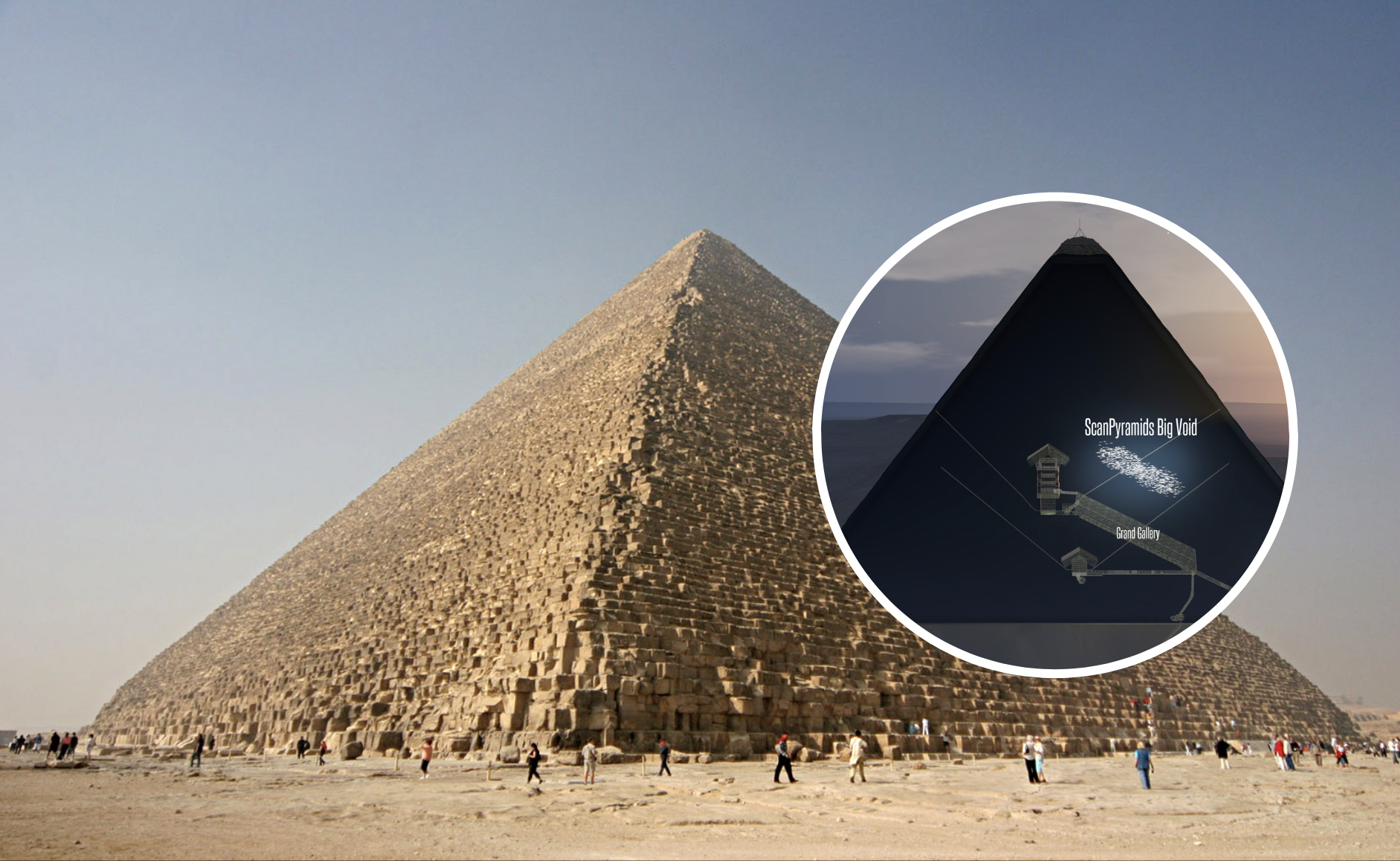Bizarre
There Is A Massive Void Hidden Inside The Great Pyramid Of Giza, Totally Sealed For Over 4,500 Years
An enormous cavern can be found on the inside of the Great Pyramid of Giza.

An enormous cavern can be found on the inside of the Great Pyramid of Giza. The room’s function is unknown, and it was shut up when the pyramid was finished being constructed some 4,500 years ago. However, some people believe that it may have been a hidden burial chamber for the pharaoh Khufu, who was responsible for ordering the construction of the pyramid.
Using muon tomography, a group of researchers going by the name ScanPyramids scanned the Great Pyramid of Giza in 2017. Muon particles are negatively charged subatomic particles that are created when cosmic rays smash with atoms in the upper atmosphere of the earth at a rate of approximately 10,000 per square meter every minute.
“Like X-rays, which can penetrate the body and allow bone imaging, these elementary particles can keep a quasi-linear trajectory while going through hundreds of meters of stone before decaying or being absorbed,” the team explains in their study. “By recording the position and the direction of each muon that traverses its detection surface, a muon detector can distinguish cavities from stone.”
Cosmic rays were used to discover something truly magnificent
All of this is just a roundabout way of saying that they looked into the Great Pyramid using a pretty clever method, one that involved cosmic rays no less. And once inside, they discovered a room that had never been explored by anyone before.
“We report the discovery of a large void (with a cross-section similar to that of the Grand Gallery and a minimum length of 30 metres [98 feet]) situated above the Grand Gallery,” the team wrote. “This constitutes the first major inner structure found in the Great Pyramid since the nineteenth century.”
They gave it the pretty fitting name of “big void,” and they validated it by utilizing three separate muon detection techniques. Although there have been hypotheses put up, it has not yet been determined what the void was supposed to be used for. An archaeologist from the University of Cambridge named Kate Spence told National Geographic that the empty space could be the result of how the pyramid was built. According to Spence, an internal ramp was used to move roof blocks into position, and afterward, the space was either left empty or filled with rubble in a loose manner.
One of the hypotheses that have been proposed to explain the function of the room is that it was Khufu’s hidden burial chamber. During the initial opening and exploration of the pyramids in the 19th century, researchers discovered a number of chambers, one of which had a sarcophagus that was believed to contain Khufu himself. This sarcophagus was located in one of the pyramids. However, when the sarcophagus was opened, it revealed that it was devoid of its contents.
But where did the remains end up?
The assumption that the remains were taken has been around for a long time, and it hasn’t changed. However, prior to the discovery of the fourth chamber, people had speculated that there was a hidden chamber that held Khufu’s mummy. This speculation came long before the chamber was actually found. In 2004, two French amateur Egyptologists proposed a theory that there was an additional chamber by using ground-penetrating radar and architectural research to substantiate their assertions. They believed that the chamber could have been used for ceremonial purposes.
The two contended that contrary to popular belief, the pyramid was not painstakingly sketched out in advance but rather developed organically as construction progressed. It was hypothesized by the architect of the pair, Gilles Dormion, that the pyramid was altered when the builders recognized that certain chambers in the pyramid would not be able to support the weight of the burial sarcophagus. In the king’s chamber, there are enormous granite beams that have massive fractures in them. These flaws, which have been ascribed to earthquakes that have occurred since the pyramid was constructed, are there. On the other hand, he thinks that the fissures appeared while the pyramids were being constructed because there were remnants of ancient plaster were discovered inside of them.
Kufu had to have been buried in the second chamber… Here’s why
“At the end of the day,” Dormion said of the theory in 2004, “the entire problem of the Great Pyramid can be summed up by this theory: Khufu had three funeral chambers built for himself. The first remained unfinished, the second was available and the third cracked. Khufu was therefore interred in the second.”
Until we have a clearer look at the gap itself, it may be a bit optimistic to think it is a hidden burial chamber for the king, rather than a ramp used in the pyramid’s construction, but the amateurs thought that the chamber where Khufu was interred extended from a concealed corridor from the queen’s chamber (a misnomer, since the chamber was likely used as a gift chamber for Khufu), pretty far from where the enormous void was afterward discovered. The good news is that we might get a better look at it soon.
In the year 2022, a group of people revealed their intentions to photograph the pyramid utilizing more advanced technology. “We plan to field a telescope system that has upwards of 100 times the sensitivity of the equipment that has recently been used at the Great Pyramid,” the team writes, “will image muons from nearly all angles and will, for the first time, produce a true tomographic image of such a large structure.”
The group estimated that it would take two years to construct the detectors once the money was secured.
Typos, corrections and/or news tips? Email us at Contact@TheMindUnleashed.com
